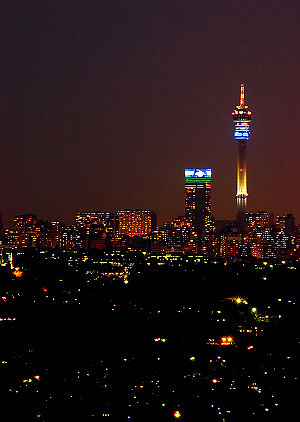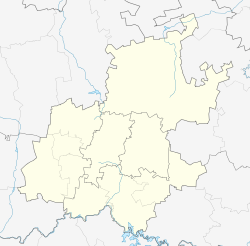|
Hillbrow
 Hillbrow ( /ˈhɪlbroʊ/) is an inner city residential neighbourhood of Johannesburg, Gauteng Province, South Africa. It is known for its high levels of population density, unemployment, poverty, prostitution[2] and crime. It had a large and active Jewish community for much of the twentieth century and housed several Orthodox synagogues such as the Great Synagogue and Poswohl Synagogue. Temple Israel, the oldest Reform synagogue in the country, continues to hold services. In the 1970s it was an Apartheid-designated "whites only" area under the Group Areas Act, but later became a "grey area", where people of different ethnicities lived together. It acquired a cosmopolitan and politically progressive feel, and was one of the first identifiable gay and lesbian areas in urban South Africa. However, due to the mass growth of the population of poor and unemployed people after the end of Apartheid, crime soared and the streets became strewn with rubbish.[3] This, together with lack of investment and fear led to an exodus of middle-class residents in the 1980s and the decay of major buildings, leaving in its wake an urban slum by the 1990s.[4] Today, the majority of the residents are incoming migrants from the townships, rural areas and the rest of Africa, many living in abject poverty. An urban regeneration programme is underway. There are street markets, mainly used by local residents, and the Johannesburg Art Gallery contains work by major local artists including William Kentridge. HistoryPrior to the discovery of gold on the Witwatersrand in 1886, the suburb laid on government owned land called Randjeslaagte that now makes up the Johannesburg CBD. It was a triangular shaped piece of waste land not used for farming and the future suburb lies in the northern apex of the triangle. The origin of its name is simple, the suburb lies on the brow of the east west mountain ridge that crosses the Johannesburg CBD.[5] The land was owned as claims by J. Nicholls who sold them to Transvaal Mortgage, Loan & Finance Company.[6]: 129 It was laid out as a residential suburb during 1894 and 1895, with Richard Currie auctioning the stands.[5][6]: 129 In 1897 it became part of Johannesburg's Sanitary Board.[6]: 129 After World War Two, developers started purchasing the stands at values beyond their worth and eventually turned it into blocks of flats.[6]: 129 Jewish communitySince the beginning of the 1920s, Hillbrow was home to a growing and stable community of Jewish residents.[7] Jewish residents and investors were responsible for building most of Hillbrow's buildings.[8] The neighbourhood was also home to a number of popular meeting places for Jewish residents, such as the Florian cafe on Kotze Street.[8] In later decades the cafe was often frequented by Jewish and non-Jewish patrons on the political left. It was here that Jewish anti-apartheid activist, Rusty Bernstein began to develop his political consciousness. He was with Kurt Jonas, son of German Jewish migrants and his fellow student at the Architecture School of the University of the Witwatersrand. Through this encounter with Jonas he learned of "the invisible world of black workers and trade unions which existed on my own doorstep."[9] The former Great Synagogue is located on Wolmarans Street. It is considered the city's mother synagogue and "the crown jewel of Orthodox Judaism in South Africa."[10] Hillbrow is also home to Temple Israel, the oldest Reform synagogue in the country.[11] The Art Deco building was designed by Herman Kallenbach and has been granted heritage status.[12] Hillbrow is also home to the former Poswohl Synagogue on Mooi Street.[13] The name refers to Pasvalys in Lithuania where the original members emigrated from at the turn of the century.[13] It was declared a National Monument under old NMC legislation on 4 December 1981.[13] In the 1960s and 1970s, many elderly Jewish people purchased flats in Hillbrow, planning to stay there for the final chapter of their lives.[8] There was an uptick in Jewish migration out of the inner city suburbs into the northern suburbs from the mid-1970s.[8] In 1967 the press reported confrontations between local Jewish youth and German immigrants at a beer hall in Hillbrow. The Germans made Hitler salutes, prompting protests from local Jewish youth. The West German embassy in South Africa issued a statement deploring the salute, blaming “irresponsible youths who were too young to experience Nazism” for celebrating the regime. Gideon Jacobs, a member of the opposition requested that the confrontations be the subject of a discussion in parliament.[14] A South African branch of the British neo-fascist National Front was established in 1978 and spread anti-semitic and racist pamphlets about Jewish landlords renting to non-white tenants in the suburb.[15] A number of Jewish architects also contributed to Hillbrow's urban landscape. Architect Harold Le Roith sought to "green" the neighbourhood by introducing pavement gardens and planting to Golden Oaks, an apartment building he designed in 1976.[16] He also designed Cresthill Mansions in Hillbrow, which is now used as social housing.[17] In the 1970s, Jewish couple, Isaac and Gloria Rootshtain purchased the Cranbrook Hotel on 58 Leyds Street. The building, a residential hotel, had been designed by Harold Le Roith and featured in Britain's influential The Architectural Review magazine in 1953.[18] The couple reopened the hotel as a kosher hotel, renaming it The Connoisseur. [19] Gloria wrote South Africa's first celebrity cookbook, Cooking with a Connoisseur in 1982.[19][20] The Connoisseur operated as a kosher hotel until its sale in 1989, when the Rootshtain's made aliyah to Israel.[20] A small number of mostly elderly and impoverished Jews continue to live in Hillbrow and neighbouring Berea.[21] They are mostly supported by Jewish charities in Johannesburg.[21] Gay communityIn the mid-20th century, Hillbrow developed a reputation for its growing gay community. Many gay establishments and publications were founded in Hillbrow from the 1960s forward. The gay community was strong and large enough in Hillbrow that the conservative ruling National Party, which instituted apartheid, fielded a pro-gay rights candidate, Leon de Beer, in the 1987 elections. De Beer's victorious campaign was heavily advertised in the Hillbrow-based gay publication Exit and his campaign promises were to both advance gay rights in parliament and reinstate Hillbrow as a whites-only district.[22] His campaign garnered enough support from the gay community that he won the election, becoming the first elected official in South Africa to run and win on a pro-gay platform.[23][24] In 1990, one of the first training and information centres for HIV in South Africa was established in Hillbrow, initially catering mainly to white gay men. As the racial demographic in Hillbrow radically shifted, so too did the people in need of HIV-related care, and by the late 1990s the clinics mainly worked with black heterosexual women. Hillbrow experienced a heavy decline and most of the gay community, which was predominantly white, left the area within the decade. Social actionA number of social action groups and organisations exist in the suburb to alleviate the difficult conditions challenges. In 1990 Jean du Plessis and Adele du Plessis founded The House Group, an organization with several shelters and programs aimed at retrieving and rehabilitating female child victims of commercial sexual exploitation. The organization's first address in Hillbrow was on 52 Soper Road, close to Ponte City. In 1993 they moved to two adjacent premises on 60 Olivia Road (at the foot of the Hillbrow Tower) where the organization had The House Drop-in Centre and Intombi Shelter. The House Group were pioneers in pushing for legislation that would provide for equal rights for girls in shelters (legislation already supported boys in shelters). In 1997, the Gauteng Provincial Government proclaimed the first legislation that allowed shelters for female children. LandmarksConstitution HillThe Constitution Hill precinct, seat of the Constitutional Court of South Africa, is located on the western edge of Hillbrow, and is part of a major government and private sector initiative to revitalize the area and the rest of the CBD. Hillbrow TowerThe Hillbrow Tower, a telecommunication tower, dominates the Johannesburg city skyline, featured in many picture postcard views of the city. It has become a symbol of the city and appears in the city seal. Completed in 1971, it rises to a height of 270 metres, thus making it the tallest man-made structure with a lift in Africa. Initially named the JG Strijdom Tower, it became popularly known simply as the Hillbrow tower, and in May 2005 it was renamed to Telkom Joburg Tower, with its new name displayed prominently in lights. It once featured a luxury rotating restaurant, but that was closed in 1981 due to security fears and is unlikely to be reopened. Ponte CityPonte City is the tallest residential building in Johannesburg and one of the city's most striking urban landmarks. It was designed by architect Rodney Grosskopff (who also designed other South African landmarks such as the Johannesburg Civic Theatre) and completed in 1975. The building is distinct due both to its height, rising to 54 storeys above one of the highest points in Johannesburg, as well as its cylindrical shape. During its prime, Ponte City was one of the city's most sought-after addresses, but with inner-city urban decay setting in, it has become run-down, over-populated, and unsafe. The building was placed under new management in 1999, and with regular maintenance reinstated and gradual restoration, coupled with council, provincial, and government initiatives to rehabilitate Hillbrow, it began to find some shine again. In February 2007, Danny Boyle, the British director of Trainspotting, announced plans to use the building as a film set in a future release.[25] In popular culture Literature
Music
Film
DocumentaryIn 2000, Michael Hammon and Jacqueline Görgen directed a documentary named Hillbrow Kids, depicting the struggles of a group of street children in post-apartheid urban South Africa. In 2007, BBC Two reporter Louis Theroux ran a documentary called Law and Disorder in Johannesburg.[27] The documentary depicted the state of complete abandon and lawlessness in some parts of the city, specifically in Hillbrow. In January 2013, Al Jazeera English aired a Witness documentary about Hillbrow described as "A personal journey to Hillbrow, where human spirit, hope and enterprise triumph in this crime-ridden melting pot in the heart of South Africa."[28] PhotographyThe suburb was the subject of several photographs by the renowned photographer, David Goldblatt. "Hillbrow, Johannesburg, South Africa 1973" depicts a white family amid the context of the Group Areas Act designating the area "Whites-only".[29] "Domestic Worker on Abel Road, Hillbrow, Johannesburg March 1973", depicts a black domestic worker.[30] Both photographs are held by the Museum of Modern Art in New York City.[31] "Sunday morning: A not-White family living illegally in the "White" group area of Hillbrow, Johannesburg" depicts a black family living in Hillbrow in defiance of the Group Areas Act. The photograph is part of the collection at Yale University Art Gallery in New Haven, Connecticut.[32] In 2010, some of his Hillbrow photographs featured in the exhibition "South African Photographs: David Goldblatt" at the Jewish Museum in Manhattan. They included "Holdup in Hillbrow, Johannesburg, November 1963", depicting a small white child with a toy gun playing with a black man.[33] "Baby with childminders and dogs in the Alexandra Street Park, Hillbrow, Johannesburg, 1972" shows a white baby with black childminders.[34] These photographs were on loan from the Goodman Gallery in Johannesburg for the exhibition. His other photographs from the area include: "The watchman, Balnagask Court, Hillbrow. June 1972", "Woman shopping, Hillbrow. 1972" and "Man with an injured arm, Hillbrow. June 1972".[35] Notable people
References
Bibliography
External linksWikimedia Commons has media related to Hillbrow. Information related to Hillbrow |
||||||||||||||||||||||||||||||||||||||||||||||||||||||||||
Portal di Ensiklopedia Dunia


